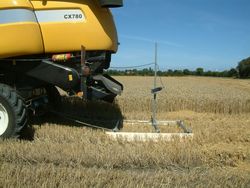The process optimization Soil/Plant
The process optimization Soil/Plant includes the process chain for the entire vegetation period beginning with the harvest, continuing through the stubble tillage, primary and secondary soil tillage, seeding, fertilizing, care and concluding again with the harvest. This allows a holistic consideration of the tasks in the sense of good professional practice.
The harvest tasks are important since they serve as the basis for the quality of the subsequent tasks. The length of stubble, the chopping quality and the even distribution of straw on the land must be in accordance with differentiated crop, soil and field hygiene requirements.
Unwanted plant growth following a harvest is increasingly a challenge. Here in the framework of the area stubble tillage, it is necessary to work levelly to induce the germination of seeds from weed grasses, and above all from oil crops (shatting rape), as completely as possible to prevent harvest losses. Plants and stubble residues infected with fungal or animal pests should be chopped finely in order to kill the pests. For this reason flat working curry-comb and flailing rotary tillers play a very important role in our current research tasks. The field studies are related to detailed laboratory studies. Included here is, for example, the evaluation of maize ear fusarium with automatic image analysis, carried out in cooperation with the JKI. The goal is to describe objective criteria for the approval processes for fungicides.
After the complete germination of weed grasses and falling seeds, the basic tillage of the soil begins. This is adapted to various working depths due to the changing soil conditions on partial areas in order to optimize the use of soil water and soil air reserves in the sense of good professional practice and to conserve the soil structure. Partial area-specific tillage presents the greatest challenges for straw distribution and stubble tillage.
Simple solutions for plant protection problems, such as for example observing hygiene criteria in the crop sequence are, according to our results, no longer to be expected in the future. Mechanical maintenance and chopping are increasingly of central significance for the fighting of weeds. The use of hoeing techniques requires wide distance rows, at least double rows, better distances of 3-4 grain rows. In sugar beet crops hoeing was standard and is currently being revived with further developments. The use of precision seeding techniques, equipped with GPS, makes seeding in rectangular and square areas possible for the first time and meets the requirements for mechanical maintenance with criss-cross hoeing.

![[Translate to English:] [Translate to English:]](/media/_processed_/3/6/csm_Hintergrund-Ausschnitt1_9daaef6b89.jpeg)
![[Translate to English:] [Translate to English:]](/media/_processed_/3/6/csm_Hintergrund-Ausschnitt1_0bd7111163.jpeg)















